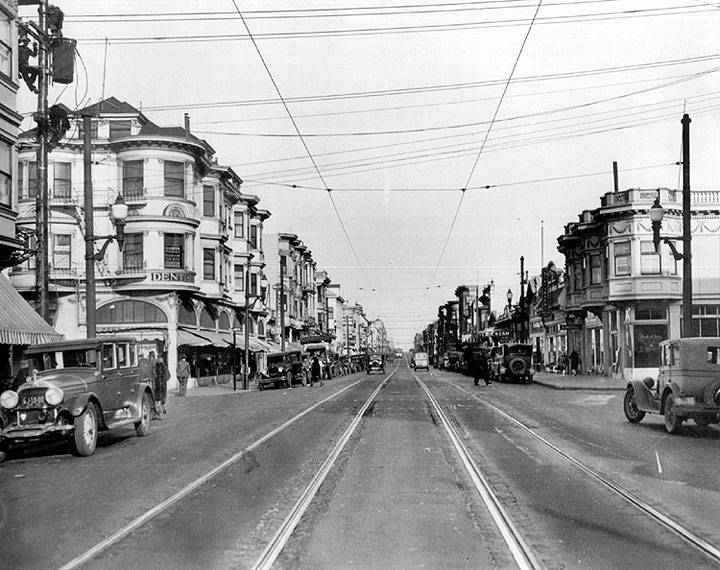Category:Haight-Ashbury
Haight & Clayton: 1936
Photo: Private collector, San Francisco, CA
Text partially excerpted from 'The District Handbook: A CORO Foundation Guide'
Prior to 1870, the Haight-Ashbury was basically a rural suburb of the burgeoning City of San Francisco. Pope Valley, the name for the less hilly lands south of the Panhandle, was the first area settled.
In 1870, the San Francisco Park Commission was formed by California Governor Haight to develop Golden Gate Park. This was a key factor in the growth of the Haight-Ashbury neighborhood as a social and commercial entity. In 1883, the first cable car line opened along Haight Street (named for the former Governor). The principal pedestrian entrance to the park at Stanyan and Haight Streets became the focal point of many transportation lines.
The simultaneous development of the park and transportation system, as well as the lack of rival commercial centers adjacent to the park, transformed the Haight area into a center for such activities. In 1895, an amusement park, called "The Chutes," opened on Haight Street.
Because of these commercial and social developments, the area became a desirable neighborhood and attracted many well-to-do and middle class residents, particularly on the flat lands.
The 1906 earthquake and fire caused a migration of the CIty's survivors to the western areas not destroyed by the fire. This post-earthquake boom increased the economic and ethnic diversity of the Haight. Through the years the Haight changed with the invention of automobiles which allowed families to move into the suburbs. The increased use of the automobile lessened the importance of both the streetcar system and the Haight's proximity as a gate to Golden Gate Park. The flight of wealthy and middle class people from the Haight continued for many years.
This resulted in dramatic changes within the social and economic makeup of the area. Property deteriorated as older residents continued to move out and lower income families moved in. During the 1960s the beatniks of North Beach settled in parts of the Panhandle, the forerunners of the hippies.
The commercial decline, the decreasing importance of the Haight area within the city and the lower rents combined to create the perfect refuge for young people fed up with their parent's values, and the Haight became the central point for hippie culture in the late 60s.
Pages in category "Haight-Ashbury"
The following 144 pages are in this category, out of 144 total.
1
A
B
- Baseball 1886-1903
- Big Brother & The Holding Company: The 1978 Sam Andrew and James Gurley Interview
- Big Brother and the Holding Company: Cheap Thrills
- Bob Weir on Psychedelic San Francisco and the Birth of the Grateful Dead
- Bound Together: An Anarchist Collective Bookstore
- Buena Vista History
- Buena Vista Park
- Buena Vista Peak
C
D
E
F
H
- Haight and Baker
- Haight Ashbury Free Clinic
- Haight Ashbury Literary Journal
- Haight Chutes
- Haight Street 1940s
- Neighborhood/Geography
- Haight-Ashbury Architectural Tour beginning
- Hip Capitalism Fails
- History of Redlining in San Francisco Neighborhoods
- Huckleberry House and Teenage Runaways
- Human Be-In
- Human Be-In, 1967
- Hunter's Point riot by Fleming
I
L
M
N
P
R
S
- Safe with the Gaping Maw
- San Francisco 49ers at Kezar Stadium
- San Francisco Bay Area People’s Food System
- San Francisco Diggers
- San Francisco Tape Music Center
- San Francisco’s Free Emergency Services: Gone and Forgotten
- Second Freeway Revolt
- Senator Alan Cranston: Hawkish Dove
- SF Community Recycling
- Shrader between Page and Oak
- Sisters Restoring Justice
- Southern Pacific Hospital
- St. Agnes Church
- Straight Theater demolished
- Summer of Love?
- SURPLUSES and DISTRIBUTION
T
- Talks: 2020 Videos
- Talks: Art & Politics / 2020-
- That Office!: A Year's Worth of Journals About Working and Not-Working
- THE ACID TEST
- The Chutes
- The Digger Concept of 'Free'
- The Duboce Bikeway Mural: Gateway to the Wiggle
- The Early Digger Papers
- The First Grab
- The Freeway Revolt
- The Haight Ashbury
- The John Coltrane Church
- The Language in Trouble—The Late 1960s
- The Medical Industry
- The Panhandle
- The Psychedelic Era
- The Recyclergy
- The Spring Mobilization Committee to End the War in Vietnam, 1967
- Those “Plucky” Forty-Niners: The Roots of Pro Football in San Francisco
- Tract Housing on Page

